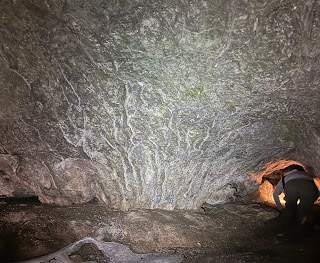I recently explored the Lost Canyon -Valley of 13 Caves Trail in the Whitewater Canyon Wildlife area on a hike sponsored by the
She Explores Driftless Facebook hiking group. This Dubuque IA-based group was started by naturalists who wanted to hike for fun outside their jobs. They share their passion for the outdoors and encourage women to build confidence in going out, exploring and creating friendships.
This hike and group sounded right up my alley. And who wouldn't want to hike through an area called the Lost Canyon and explore the Valley of 13 Caves?!?
Dubuque and Jones Counties Conservation Boards cooperatively manage the Whitewater Canyon Wildlife Area. Over 500 acres are contained in the area with a number of designated trails. Hunting, hiking, angling, paddling and winter silent sports are all welcome in the wildlife area.
Our hike was described as: "2 miles on uneven hiking trails and hiking off trail on rocky & steep hillsides to access caves along the trail. Some caves are large enough to stand in, while some caves (for our adventure-seekers) require crawling. Wear sturdy shoes, a headlamp, and clothing that can get dirty." Sign me up!
 |
| Limestone cliffs |
I arrived at the
Whitewater Canyon Area trailhead near Dubuque in Bernard IA. There I met group of about 20 women from the greater Dubuque area (and some even further) who were raring to go on our cave-finding adventure.
The 2.5 mile Lost Canyon trail (which includes the Valley of 13 Caves) follows a wide grassy path through a huge prairie area before it begins to descend into Lost Canyon. As soon as you start your descent, you see huge limestone rock formations on both sides of the now wooded hills. As we went further along the trail these formations towered over us and multiple caves could be seen up the steep hillsides.
 |
| Small stalactites |
Along the way, we were guided by naturalist Taylor Schaefers who shared plant identification, geology and history of the area in a conversational back-and-forth. Who knew that the Kentucky coffee trees we were seeing were initially planted by indigenous people near their dwellings and used for medicinal, recreational and spiritual practices. We do now!
The hike itself was at a mellow pace and people could choose the level of challenge they were most comfortable with. I can only describe it as joyful.
 |
Cave bacon next to an explorer
heading into another chamber |
As to the caves, they were 100% worth the drive. While we didn't explore all 13 (and no doubt more) caves, we took time to explore five or six. Most of these were large enough to stand up in. Some featured large openings, others we squeezed under low openings before we stood up. For the more adventurous, often the caves had small openings on the sides or in back that revealed narrow chambers to crawl in and explore further.
 |
| Fossil in the cave wall |
Some of the caves were dry, others featured continuous dripping water from the ceiling and walls that creates tiny, calcified stalagmites, stalactites and cave bacon.
With our headlamps, we could also explore the walls and ceilings, looking for marine fossils embedded in the limestone. At one time, this area, like ours, was undersea. Limestone holds a rich fossil record of trilobites, shells, cephalopods and receptaculites.
 |
| Baby bloodroot |
Because I was 100 miles south of my stomping grounds, I was delighted to see many early wild ephemerals that are nowhere near bloom -or sprout- time here in the La Crescent area. Spring beauties (their leaves are edible!); sharplobe and roundlobe hepatica; just about bloomed Dutchman’s Breeches; and a tiny delicate bloodroot made their appearance.
 |
| Walking Fern |
I spotted purple-margined liverwort and fern moss and was also introduced to a new-to-me fern: the walking fern. My eyes were bedazzled by this young growth after so many brown months.
After the hike at a nearby taproom, some of us gathered. Laughs, conversation and many ideas for hikes in the area were shared. Thanks Taylor, Andrea, Diana, Megan, Emily and others for all the ideas.
THE HIKEFrom it's start on top the prairie, this grassy, 2.5 mile loop trail descends 250 feet into a wooded valley with huge limestone walls and tumbled rocks. On each side of the wide fairly flat trail, the steep hillsides climb towards multiple caves which are open to exploration. There are a few faint paths to follow up to them. A headlamp or flashlight reveals many calcified (and growing) formations like stalactites and stalagmites as well as embedded fossils in ceilings and walls. A last short, steep hill brings you out of the woods and back to a prairie with expansive views of the countryside and back to the trailhead.
The Location 29912 9th Avenue, Bernard, IA
25 miles southwest of Dubuque off Hwy 151, head south on Curoe Rd. Follow the park signage until you see a last sign indicating a right turn at the entrance. Follow the gravel road to the large parking lot. There is a pit toilet available. The Lost Canyon trail is marked and begins to the south of the parking lot kiosk.
 |
| She Explores Driftless hikers |
Looking for more area hikes? Please stop by the web version of the blog and under the "Labels" tab on the right hand side of the blog, click on "find-a-hike". There are over 75 hike descriptions and lists of hikes to try!








No comments:
Post a Comment